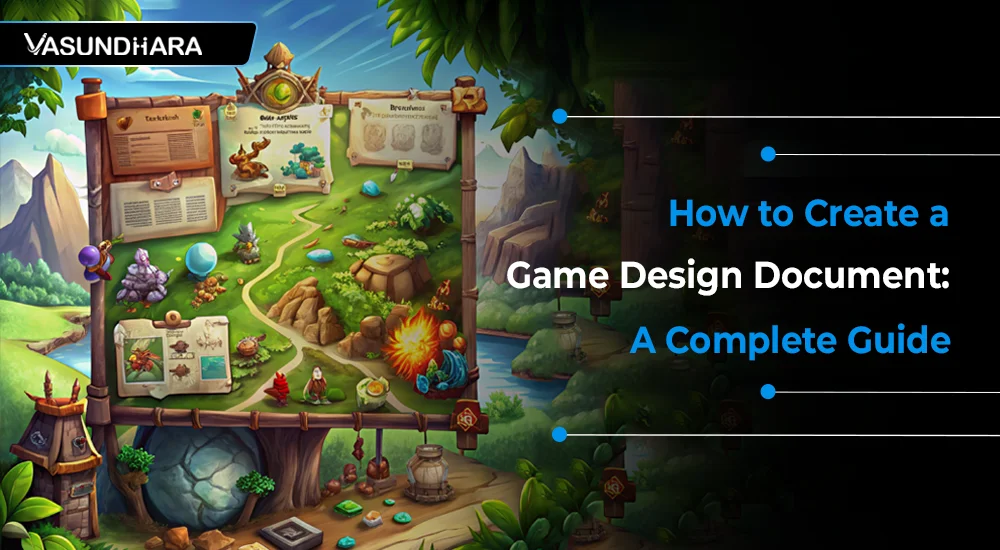How to Create a Game Design Document: A Complete Guide


- Nov 14, 2024



A well-crafted Game Design Document (GDD) provides that vision, acting as a roadmap to guide developers, artists, and designers throughout the process of creating a game. Whether you're an indie developer or working in a large studio, a GDD can streamline communication, ensure that your project stays on track, and help avoid costly mistakes later on.
In this comprehensive guide, we’ll walk you through the process of creating an effective Game Design Document step by step. By the end of this guide, you’ll have a clear understanding of what a GDD is, why it’s important, and how to make game design document.
A Game Design Document is a highly detailed blueprint that outlines the vision, gameplay mechanics, storylines, characters, level design, art style, and more for a video game. It acts as a reference guide for everyone involved in the game development process—programmers, designers, artists, and testers alike.
The GDD’s primary function is to consolidate all the different aspects of game development into a single document, ensuring that everyone shares the same vision. It’s a living document, meaning it will evolve as the project progresses and as new ideas, challenges, or opportunities arise.
Also read: Why Vasundhara Infotech Stands Out as a Top Game Development Company
A Game Design Document (GDD) is a vital tool in game development, serving as a roadmap that guides the entire process. It outlines the core concept, gameplay mechanics, story, art style, technical requirements, and other essential elements of the game. The importance of a GDD lies in its ability to maintain consistency and ensure smooth collaboration between different departments, including designers, programmers, artists, and marketers.
Without a clear GDD, team members can easily misinterpret the game’s vision, leading to miscommunication, design errors, and wasted resources. By documenting every detail, from character abilities to level design and sound effects, the GDD keeps everyone aligned and reduces confusion.
A well-structured GDD also acts as a reference point when decisions need to be made or the project scope changes. It allows the team to stay on track and make informed adjustments without losing sight of the original goals. For project managers, the GDD is an invaluable tool for tracking progress, assigning tasks, and ensuring deadlines are met.
In short, a GDD is crucial for keeping game development organized, focused, and efficient, leading to a smoother workflow and a better final product.
Also read: Partner With The Top Game Development Studio In Surat
A Game Design Document (GDD) is the foundational blueprint that outlines every aspect of a game’s design, structure, and mechanics. It is essential for ensuring that everyone involved in the game development process—from designers and developers to artists and writers—has a clear understanding of the vision and requirements.
This document guides the team from concept to completion, ensuring alignment, consistency, and a smoother development process.
Here’s a detailed guide on how to create a comprehensive game development document:
This section introduces the overall concept of the game, offering a clear idea of what it’s about.
In this section, define how the game will be played, highlighting the gameplay mechanics and systems that will be at its core.
If your game includes a narrative element, this section covers the story, world-building, and character profiles.
Also read: Current Trends in Custom 3D Mobile Game Development
This section focuses on the game's artistic direction.
This section covers the game's sound and music design.
Here, you specify the technical details of the game's development.
For games with a revenue model, detail how the game will generate income.
This section provides a clear roadmap of the development process.
Also read: Why is Mobile Game Development a Profitable Investment?
Detail the testing plan to ensure the game functions smoothly.
Explain the support that will be provided after the game's release.
Also read: Why Choose Vasundhara Infotech for Best Game Development Solution?
Creating a Game Design Document is an essential step in the game development process, helping to ensure that every team member is aligned and that the game meets its objectives. With a detailed GDD in hand, you can avoid costly mistakes, stay on track, and create a game that’s both fun to play and successful in the market.
At Vasundhara Infotech, we specialize in game development, and our experienced team of developers, artists, and designers can help turn your game concept into reality. Whether you need assistance with game design, development, or both, we’re here to guide you through every step of the process.
Get in touch with us today to start your journey toward creating an unforgettable gaming experience!
Copyright © 2025 Vasundhara Infotech. All Rights Reserved.